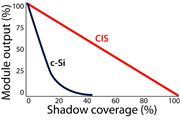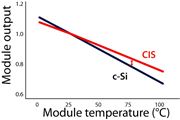Thin-Film Solar Panels
Introduction
The worldwide demand for energy is doubling every 15 years. While our limited stock of fossil fuels is being drained there is a source of our electricity that takes advantage of an abundant and free energy source – the sun! The sun transfers more energy to the earth’s surface in one hour than the world uses in a year. And people are interested in shifting to environmentally friendly solar power as an energy source, to provide renewable and sustainable power to benefit current and future generations.
Worldwide there has been a great deal of interest in improving the quality and performance of solar power systems. The advanced battery technology has seen a big improvement to our ability to store generated power (see Tesla powerwall blog, lithium blog). Here we discuss improvements to in the efficiency of converting solar energy to electricity with more advanced solar panels.
Solar Panels
Solar panels are a collection of photovoltaic solar cells on a flat plane that can turn sunlight directly into electricity through the photovoltaic effect. They are traditionally roof-mounted as fixed rigid units.
Solar panels have been traditionally made from crystalline silicon on one pane of glass. This accounts for roughly 80% of solar photovoltaics used today. But scientific research has resulted in evolving technology and has seen a new generation of more sophisticated solar products. One such product is thin-film which is composed of materials used to produce semi-conductive layers in a solar cell sandwiched between 2 panes of glass. The layers are each only 1 micron thick (compared to 350 microns for silicon), hence the name “thin-film”. Thin-film solar cells are configured to create a current of electrons when exposed to sunlight, as the electrons are dislodged in the presence of light photons. The cells are lighter, more flexible and more durable than cells that use older technology. And a big advantage of thin-film panels is that they work more efficiently in low light and cloud, where they continue to generate energy efficiently even if part of the solar panel is shaded.
Types of thin-film Solar Panels
There are primarily three types of thin-film solar panels available.
Amorphous silicon (s-Si)
The first thin-film solar cells developed were based on amorphous silicon (s-Si). Despite their initial success - including use in our pocket calculators - the demand for a-Si has declined because of low efficiency rates, with many of its manufacturers retiring production. Although they have the advantage of being environmentally friendly, s-Si have been largely replaced by the more efficient CdTe and CIS thin-film technologies.
Cadmium telluride (CdTe)
Cadmium telluride (CdTe) is the 2nd most used solar material in the world. It is cheap to manufacture and has good levels of efficiency. But its main downside is that cells use a large amount of cadmium. This heavy metal is a carcinogen that accumulates over time in the tissues of plants and animals (although cadmium is less toxic in the form of CdTe). The EU Restriction of Hazardous Substances (RoHS) directive has imposed heavy restrictions on cadmium, allowing a maximum level of 0.01% in all products manufactured or imported into Europe. However the RoHS directive make an exception for cadmium in the form of CdTe solar panels, due to their environmental benefits. The principal manufacturer of CdTe solar panels is First Solar Inc., a company who are a leading global provider of solar products.
Copper indium gallium selenide (CIS)
Copper indium gallium selenide (CIS) are the highest performing thin-film solar panels to date, and contain less of the toxic cadmium. Also known as CIGS, their leading manufacturers include Hanergy and Solar Frontier. About 20% of the energy that strikes a solar cell is converted to energy by CIS thin-film solar cells which is on par with the 15-25% converted with crystalline silicon solar panels.
Advantages of CIS thin-film –v- conventional Silicon panels
As well as their high efficiency, low toxicity and favourable manufacturing costs thin-film solar panels have additional benefits – particularly for those of us who live in a less sunny areas and who may have shaded roofs. They also work early in the morning and later in the evening when the light is lower. Although their absorption efficiency is slightly less that crystalline silicon panels, the function in lower light gives them an overall better power output. Unlike other panel types, the power output of CIS thin-film panels increases following their initial exposure to sunlight after installation, making them actually more effective than their factory specification.
Data to support CIS thin-film advantages compared to conventional solar panels are illustrated below.
Key benefits of CIS thin-film technology -v- conventional Silicon (c-Si) solar panels
Shade tolerant
The circuits in a CIS panel are configured as a matrix with many parallel current paths. In partially shaded conditions, crystalline panels (series wired cells) will deteriorate very quickly as the current through the whole panel is limited by the cells that are shaded. However, CIS thin film panels suffer only partial losses relative to the area that is shaded; the rest of the panel ‘matrix’ continues to perform at maximum.
Low light response
Solar panels are tested at laboratory conditions (standard test conditions, STC’s) which are not representative of the UK climate. In ‘real world’ conditions, CIS thin film panels produce higher performance than crystalline in lower levels of irradiation. They are therefore well suited to UK conditions.
Stable temperature coefficient
Solar panels like the cold, honestly they do! The efficiency of the panels falls as cell temperature increases and the cell temperatures are typically 25 to 30 degrees higher than ambient temperature. CIS thin film yields higher results than crystalline in high temperatures. So when we do enjoy those rare hot days in the UK, thin film will be producing more power than its crystalline equivalent.
Projects using CIS thin-film
The growth and development of solar technology will depend largely on the investment in energy infrastructure by both governments and businesses. CIS thin-film technology has been adopted in several circumstances, giving it hope for a bright future.
Solar farms
In the US, the Agua Caliente Solar Project was enabled by a $967 million Energy Department loan guarantee. Running since 2014, it is now one of the largest solar panel power plants in the world, and provides enough energy from its First Solar Inc. thin-film solar panels to power 100,000 homes. It is hoped that this will increase to a maximum of 230,000 homes powered at maximum production. Operating with over 5 million thin-film solar panels on a site that is 2400 acres, the power plant has come under scrutiny for impacting on wildlife and has been the target for lawsuits. Environmentalists are in favour of a larger number of smaller projects for future solar farms.
Motoring
Tesla – a global leader in the manufacturer of electric cars – aim to greatly increase their supply of cars to customers in China. With over 2000 supercharging stations worldwide already, Tesla have a deal with Hanergy, to manufacture CIS thin-film solar panels for solar supercharging stations in China to power up their electric vehicles. Elon Musk, the founder of Tesla - who already have 70 superchargers in China - is keen to build this network of superchargers, starting with the large cities where the carports charge cars 24 hours per day. Beijing have targeted having 5 million electric cars on the road by 2020, meaning that the use of thin-film solar supercharging stations is set to grow.
The Future of CIS thin-film
Since its introduction to the solar market, financially CIS thin-film has grown slowly and reached a plateau. However, the development and optimisation of thin-film products has continued. Many countries worldwide are starting to adopt thin-film technology to help take solar power forward in an era where we hope to get a much more of our energy from the sun. And it is thought that using CIS thin-film we can reach the ultimate goal of a sustainable 25p per watt. As the affordability of CIS thin-film increases, it will hopefully benefit all of those wanting to use renewable energy in the shade.



